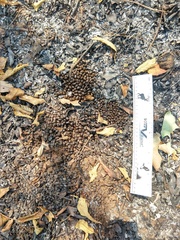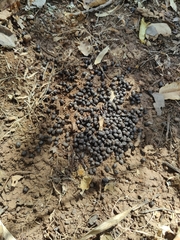Tetracerus quadricornis: taxon details and analytics
- Domain
- Kingdom
- Animalia
- Phylum
- Chordata
- Class
- Mammalia
- Order
- Artiodactyla
- Family
- Bovidae
- Genus
- Tetracerus
- Species
- Tetracerus quadricornis
- Scientific Name
- Tetracerus quadricornis
Summary description from Wikipedia:
Four-horned antelope
The four-horned antelope (Tetracerus quadricornis), also called chousingha, is a small bovid antelope native to central, South and Western India, along with a smaller population in Nepal. The sole member of the genus Tetracerus, the chousingha was first scientifically described in 1816 by French zoologist Henri Marie Ducrotay de Blainville. Three regional subspecies are currently recognised. The four-horned antelope has a yellowish-tan, sometimes reddish or goldenrod coat. It is slender with thin legs and a short tail. It stands nearly 55–64 cm (22–25 in) at the shoulder and weighs about 17–22 kg (37–49 lb). Its four horns are unique among antelopes and distinguish it from most other bovids. The longer pair of straight, spike-like horns is atop its head between the ears, while the other, shorter pair is on the forehead; its posterior horns are always longer than the anterior horns, which may even present as merely fur-covered "studs". While the posterior horns measure 8–12 cm (3.1–4.7 in), the anterior ones are usually 2–5 cm (0.79–1.97 in) long.
The four-horned antelope is diurnal (active mainly during the day) and typically solitary by nature, though some antelope may form loose groups of three to five animals, usually one or more adults, possibly accompanied by calves. This elusive antelope feeds on grasses, herbs, shrubs, foliage, flowers and fruits. It needs to drink water frequently; as such it stays in places near water sources. The breeding behaviour of the four-horned antelope has not been well studied. The age at which they reach sexual maturity and the season when mating occurs have not been understood well. Gestation lasts about eight months, following which one or two calves are born. They are kept concealed for the first few weeks of their birth. The young remain with the mother for about a year.
Four-horned antelopes tend to inhabit areas with significant grass cover or heavy undergrowth, and avoid human settlements or the presence of dogs. Once more common throughout deciduous forests in India, the four-horned antelope now occurs in disjunct, fragmented populations, with genetic "bottlenecking" (e.g. inbreeding) becoming a potential threat to the stability of future populations that do not intermingle during mating seasons. The four-horned antelope is threatened by the loss of its natural habitat due to agricultural expansion. Because of its four-horned skull and its horns it was historically a target for trophy hunters. It is presently listed as "vulnerable" on the IUCN Red List.
...Tetracerus quadricornis in languages:
- Arabic
- ظبي رباعي القرون
- Arabic
- جاوسنغا
- Bokmål
- Firehornantilope
- Czech
- antilopa čtyřrohá
- Dutch
- Vierhoornantilope
- English
- Four-horned Antelope
- English
- Chousingha
- Finnish
- nelisarviantilooppi
- French
- Antilope a Quatre Cornes
- French
- Antilope Tétracère
- French
- Choushinga
- German
- Vierhornantilope
- Hebrew
- ארבע קרן
- Portuguese
- Antílope-de-quatro-chifres
- Russian
- Четырёхрогая антилопа
- Thai
- แอนทิโลปสี่เขา
Images from inaturalist.org observations:
We recommend you sign up for this excellent, free service.







































